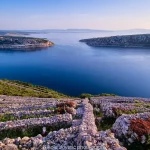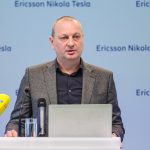Transmission and distribution are less visible, but remain vital parts of the energy system in each country.
As Darko Bicak/Poslovni Dnevnk writes on the 6th of June, 2018, for years now, the Croatian Electricity Industry has been the driving force of investment cycles in the Republic of Croatia, and big plans are in the works for the future. That’s the current position of HEP on the market, what are the challenges for them, and how they see the development of the energy sector, says Frane Barbarić, who is the president of the HEP Group Management since this year.
HEP is in a major investment cycle that has been estimated at 3.6 billion kuna a year over the next five years. Are you generally satisfied with the investment dynamics?
We’re planning an investment of three to three and a half billion per year. Of course, we’re talking about total investments at the HEP Group level. Although the public observes the investment performance of HEP almost exclusively through the prism of the construction of new power plants, large power plants, large investments somehow invisible to the public, there’s continuous engagement in the transmission and distribution of electricity, heating, gas, IT infrastructure… Now, am I satisfied with the dynamics? No, I’m not. I wasn’t satisfied with the dynamics or with the amount of investment, so we’ve proposed another, more ambitious approach over the next period, but I’m not satisfied in general thanks to the system, more specifically the approach to managing the investments. And this is one of the most important areas in which we’re talking about long-term business success, about raising the value of the company, and if you want to play a broader role in the domestic economy and society in general. We’ll do this seriously in the mandate of this department.
Which segments in the original period of the cycle have been the most invested in?
In transfer and distribution, there’s an ongoing investment continuity, together at an annual level of close to 1.5 billion kuna. For investments in the security of existing and future consumers, especially in tourist areas where there are year-on-year increases in consumption and load. We’re talking about building new and reconstructing the existing almost 300 transformers of different voltage levels. There’s also the construction and replacement of about 3000 km of network in all parts of Croatia, including the necessary mountainous areas, the Dalmatian and Primorje hinterland, Slavonia, and the islands. As for the production segment, the first part of the cycle is the revitalisation and modernisation of the hydro power plants, worth 3.2 billion kuna. This year’s cycle ends with the revitalisation of Zakučac, our largest hydroelectric power plant. The total value of the investment in Zakučac is about one billion kuna, and the power plant will increase by more than 50 megawatts. The reconstruction of another large hydro power plant in Plat near Dubrovnik has been completed. A number of other hydro power plants are under construction, such as those in Gojak, Fužine and Ozalj, and the revitalisation of Varaždin, Senj and several other large hydro power plants is being prepared. It should also be mentioned that in the first quarter of this year, the first two of HEP’s cogeneration plants in biomass, in Osijek and Sisak, were installed.
What are the latest design and development projects that are pending?
The most important was the construction of a high-efficiency cogeneration plant at the location in Zagorska ulica (Zagorje street). The new facility will replace the two dilapidated units at the site, and will allow for the continued supply of heat to the western part of Zagreb to continue. The value of that investment is over one billion kuna. The choice of contractor is under way and everything’s going according to plan. And in Osijek there is a need for a replacement solution at an existing site, ie, for the construction of a high-efficiency plant that will work in accordance with the new stringent environmental regulations. We’ll choose the variants, afer which, we’ll start with the project preparation.
What’s going on with the Kosinj-Senj project, when will hydroelectric power plant expansion begin?
This regards the use of the remaining hydropower potential on the river banks of Lika and Gacka by the addition of the existing hydro power system, which will give us more than 400 megawatts of new power from renewable sources and additional valuable energy in the system. Along with the energy, the project has many other benefits, from permanent solutions to flood problems, water supply improvement for the Croatian coast, the construction of road and other communal infrastructure… For the first part of the project, HES Kosinj, we received a positive decision from the ministry on environmental and nature impact, the second part the procedure is still in progress. If everything goes to plan, by the end of this year, or by the beginning of next year, we could begin with works on sorting out access roads. Just this project will cost about three and a half billion kuna.
How many hydro power plants are important for HEP’s future?
They are very important not only for HEP but also for Croatia as a whole. They were important in the past, let’s remind ourselves that one of the ever first power systems in the world was created on the river Krka, they’re important today and they’ll be important in the future.
Hydro power plants are an example of a project that has numerous social benefits. These are plants with a lifespan of more than 100 years, which, with the efficient production of electricity, also enable flood protection, irrigation, local water supply, improvement of transport infrastructure, development of tourism, sporting and recreational facilities on reservoirs…
I’ll give you a few examples. From the HPP Zakučac water system, Omiš and its surroundings and the islands of Brač, Hvar and Šolta are provided with water. Whoever has visited Fužine can see what a natural pearl and tourist resource Bajer lake represents. Or, for example, Sabljaci near Ogulin. Our 26 hydro power plants account for about one third of the annual electricity consumption in Croatia. As a renewable energy, they contribute significantly to the preservation of the environment and the reduction of CO2 emissions.
It should be reitereated that Croatia, with a share of renewable sources in total energy consumption of 28 percent, is in the eighth place among the EU states. Such an indicator, with the use of biomass, can mostly be owed to our hydroelectric power plants. And another important thing with regard to hydro power plants should not be ignored, is the capital investment in energy, and especially that which can employ a large part of the domestic economy, they have a direct and significant impact on GDP growth.
Of course, I’m talking about potentials, everything has to be done according to the rules of public procurement. Of all this, it’s clear why the continuation of the cycle of revitalisation and the reconstruction of HEP’s hydro power plants is very high on the list of priorities. Thanks to investments of 3.2 billion kuna, we’ll prolong the working life of the hydro power plants and gain new 150 megawatts of power in renewable sources, and the local community and the domestic industry will both feel the benefits of it.
What will happen with the Plomin Thermo Power Plant? The Plomin C project has completely disappeared from public perception…
No, it hasn’t disappeared, this topic became very hot during the public debate on the new environmental permit for Plomin 1. And we’ve been very open and clear when communicating about it. So, as a new management, we found ourselves in a situation in which the TE Plomin C project froze. A potential strategic partner for the project, Marubeni and HEP, agreed that there are some real obstacles in regard to the project’s implementation according to the conceptual model of cooperation, and agreed upon the termination of the Agreement of exclusivity last year. And certain additional market analyses and projections have indicated the need for parallel observation and the development of alternate solutions for the Plomin site. Thus, there was an option to reconstruct and modernise the first TE Plomin 1 plant, so, we’re currently considering the option of extending work on the first block with the installation of new environmental protection systems. In the period of transition to low-carbon energy production, while there’s no commercialision of the storage of energy from renewable sources, Croatia has enabled the continuation of its own domestic base power generation, and at the same time, the acceptance of new renewable power plants within the system. There are two prerequisites for realisation. The first is obtaining a new environmental permit from the Ministry of Environmental Protection and Energy, and another positive outcome of the feasibility study being developed.
How do you see the future of the domestic power sector, which technologies will define the direction of its development?
All these projects are important for HEP and for the power system because they mean long-term stability and security of supply. However, there are a number of other projects that will further define the future of HEP and the future of the Croatian power sector, which directly concern, or will be related to each individual customer or network user. All of them will get new, advanced metering devices. Everyone must be enabled to become an active buyer. Did you know that our old administrative building at HEP headquarters within the EU’s 3 Smart project will become an active buyer? It will be part of a smart micro-network with its solar power plant on the roof and the battery pack, and connected to the FER control system. In Koprivnica, we recently released a super-intelligent smart grid, the first in Croatia, and much like some features in Europe. The built-in system can detect and isolate a malfunction, reconfigure the network, and set up power so that devices such as a computer or a television set don’t feel it at all.
How does electric mobility fit into HEP’s development strategy?
Our electrification development project in Croatia is not just an excellent project, which is beneficial to HEP’s image. We’re developing it in such a way that vehicle batteries will rake on their role in the future smart grid, in the further integration of renewable energy sources. The future ahead of us can be described by 3D-decarbonisation, digitisation, decentralisation. We haven’t got a choice, HEP’s future will produce energy without or with low CO2 emissions, with the use of advanced information technology solutions in distribution and supply, and will be able to successfully operate in the environment of distributed energy production and active customers.
Small investments in renewable energy sources (wind, sun, biomass) seem to be stalling a bit. What is HEP’s position and what are your plans?
The investments in renewable sources have not been destabilised, in recent years, most of the investments related to production facilities concerned renewable sources, the reconstruction of hydro power plants, and the construction of small hydro power plants and biomass cogeneration plants.
In any case, HEP has set a significant increase in share of renewable resources in its strategy in its own portfolio, in which, among other things, there are plans to achieve the continuation of revitalisation of existing power plants, the construction of new hydroelectric power plants and the construction or acquisition of other renewable energy sources such as wind power plants and solar power plants. In the next five-year period, we’re planning to launch a program to build photovoltaic solar power plants more intensively. We’re considering several locations in Dalmatia where it’s possible to build larger power plants, of 10 to 90 megawatts. It’s also possible to acquire projects that have been developed by other entities, potential partners, and have a valid location permit.
The third is the development of a solar power plant on the rooftops of production facilities and business facilities owned by us, which will primarily depend on the development of a system for the promotion of production from renewable sources. I want to be clear, HEP will have a developmental emphasis on renewable energy sources. Before and after the adoption of the low-carbon strategy, we’re also implementing and planning projects that will definitely fit into the strategy and be a support to it. This will contribute to meeting Croatia’s international obligations and the realisation of the global goals of sustainable development, as well as to ensure HEP’s leading role in the energy transition of the country. I’m convinced that the electricity generation sector in Croatia in 2050 will be almost without CO2 emissions. After HEP won the case against Slovenia at the International Court in the Krško case a few years ago, a new case emerged with the appointment of a new board. That’s the current situation with that electric power plant.
Are you satisfied with your co-owner status, are there any major investments planned?
First and foremost, it should be noted that Krško is working securely, reliably and cost-effectively. According to independent international ratings, it belongs to the better group of nuclear power plants in Europe.
HEP is actively carrying out its co-ownership role in nuclear power, so HEP’s initiative primarily adopted a business optimisation plan, whereby production cost was reduced by about 10 percent. As far as the current situation is concerned, the Slovenian side hasn’t accepted the qualified and competent candidate for the board member that we’ve proposed, justifying it by saying that no additional qualifications are needed, specifically four years of experience in nuclear power plants at workplaces requiring possession of a nuclear license operators. It’s our position that the other party and its internal acts apply selectively and contrary to the Intergovernmental Treaty and this dispute will have to be resolved via technical arbitration. I want to emphasise that HEP’s motivation, taking into account the fact that Krško’s work was planned until 2043, rejuvenated the management of NE Krško, which was needed.
Click here for the original article by Darko Bicak for Poslovni Dnevnik







